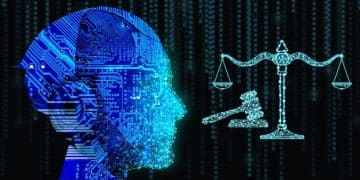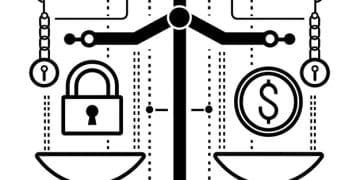AI and Surveillance: Navigating Security and Privacy in the US

AI and surveillance in the U.S. raise critical questions about balancing national security and public safety with fundamental privacy rights and civil liberties, necessitating careful ethical and legal frameworks to protect individual freedoms.
The rise of AI and surveillance technologies in the United States presents a complex challenge: how do we enhance security and public safety without infringing upon the fundamental privacy rights of individuals? This question is becoming increasingly urgent as AI becomes more sophisticated and pervasive in our daily lives.
The Expanding Landscape of AI Surveillance
Artificial intelligence is rapidly transforming surveillance practices across various sectors in the U.S. From law enforcement to retail, AI-powered systems are being deployed to monitor, analyze, and predict behavior. Understanding the scope of this expansion is crucial to addressing its potential impacts.
How AI is Used in Modern Surveillance
AI algorithms can analyze vast amounts of data, including video footage, social media posts, and financial transactions, to identify patterns and anomalies. This capability is used in diverse applications.
- Facial Recognition: Identifying individuals in public spaces, used by law enforcement and retailers.
- Predictive Policing: Analyzing crime data to forecast potential hotspots and allocate resources.
- Behavioral Analysis: Monitoring individuals’ online activity to detect suspicious behavior or potential threats.
These technologies offer the promise of increased efficiency and effectiveness in preventing crime and improving security, but they also raise significant concerns about privacy and the potential for abuse.
The Constitutional Implications
The Fourth Amendment of the U.S. Constitution protects individuals from unreasonable searches and seizures. AI surveillance technologies can potentially violate this right by collecting and analyzing data without a warrant or probable cause.
The courts are grappling with how to apply traditional Fourth Amendment principles to these new technologies. The key question is whether the government’s use of AI surveillance constitutes a “search” under the Fourth Amendment.
In conclusion, the increasing use of AI in surveillance presents both opportunities and challenges. Understanding the scope of AI surveillance and its potential constitutional implications is essential for creating a balanced approach that protects both security and privacy.

Balancing Security and Privacy: The Legal Framework
Finding the right balance between security and privacy in the age of AI surveillance requires a robust legal framework. Existing laws and regulations may not be adequate to address the unique challenges posed by these technologies.
Current Laws and Regulations
Several federal and state laws govern surveillance practices in the U.S., but they were not designed to address the specific capabilities of AI. The Electronic Communications Privacy Act (ECPA) and the Foreign Intelligence Surveillance Act (FISA) are two key federal laws that regulate government surveillance.
However, these laws often lack clear guidelines for the use of AI, leaving room for interpretation and potential abuse. For example, ECPA’s restrictions on wiretapping may not fully apply to AI-powered surveillance systems that analyze metadata rather than the content of communications.
Proposed Legislation and Reforms
Recognizing the need for updated regulations, lawmakers are proposing new legislation to address the privacy implications of AI surveillance. The Facial Recognition and Biometric Information Privacy Act, for example, would regulate the use of facial recognition technology by businesses and government agencies.
- Transparency: Requiring government agencies to disclose their use of AI surveillance technologies.
- Oversight: Establishing independent oversight bodies to monitor and regulate AI surveillance practices.
- Accountability: Creating mechanisms for individuals to challenge the use of AI surveillance against them.
These proposed reforms seek to create a more transparent and accountable system for AI surveillance, ensuring that individual rights are protected.
Ultimately, a comprehensive legal framework is needed to address the ethical and legal challenges of AI and surveillance. This framework should balance the need for security with the protection of fundamental privacy rights.
The Role of Facial Recognition Technology
Facial recognition technology is one of the most controversial applications of AI surveillance. Its ability to identify individuals in real-time has significant implications for privacy, civil liberties, and law enforcement.
How Facial Recognition Works
Facial recognition systems use algorithms to analyze facial features and match them to existing databases of images. These systems can be deployed in various settings, from airports and shopping malls to police body cameras.
Advancements in AI have made facial recognition technology increasingly accurate, but concerns remain about its potential for errors and biases. Studies have shown that facial recognition systems are more likely to misidentify individuals from minority groups.
Civil Liberties Concerns
Critics argue that facial recognition technology poses a serious threat to civil liberties. The ability to track individuals’ movements in public spaces could chill freedom of expression and assembly.
Additionally, the widespread use of facial recognition could lead to a “surveillance society,” where individuals are constantly monitored and tracked by the government and private companies.
In conclusion, facial recognition technology presents both opportunities and risks. Careful regulation and oversight are needed to ensure that this technology is used responsibly and ethically.

Ethical Considerations and Bias in AI Surveillance
Ethical considerations are paramount in the development and deployment of AI surveillance technologies. Bias in algorithms can lead to discriminatory outcomes and exacerbate existing inequalities.
Understanding Algorithmic Bias
Algorithmic bias occurs when AI systems are trained on biased data, leading them to make inaccurate or unfair predictions. This can have serious consequences in the context of surveillance.
For example, if a facial recognition system is trained primarily on images of white men, it may be less accurate at identifying individuals from other demographic groups. This can lead to disproportionate targeting and surveillance of minority communities.
Mitigating Bias and Ensuring Fairness
Addressing algorithmic bias requires a multi-faceted approach, including:
- Data Diversity: Training AI systems on diverse and representative datasets.
- Algorithm Auditing: Regularly auditing AI systems to identify and correct biases.
- Transparency: Making AI algorithms more transparent and explainable.
By taking these steps, we can work towards creating AI surveillance systems that are fair, accurate, and accountable.
The Importance of Ethical Frameworks
Ethical frameworks are crucial for guiding the development and deployment of AI surveillance technologies. These frameworks should prioritize human rights, fairness, and transparency.
They should also involve input from diverse stakeholders, including ethicists, technologists, policymakers, and community members.
Ethical considerations must be at the forefront of any discussion about AI and surveillance. By prioritizing ethical principles, we can ensure that these technologies are used for good and do not perpetuate harm.
The Impact on Civil Liberties and Freedom of Assembly
AI-powered surveillance technologies have a profound impact on civil liberties, particularly the right to freedom of assembly. The ability to monitor and track individuals can chill dissent and discourage participation in protests and public gatherings.
Chilling Effect on Dissent
When individuals know they are being watched, they may be less likely to express their opinions or participate in protests. This “chilling effect” can undermine democratic values and stifle public discourse.
AI surveillance technologies can exacerbate this effect by making it easier for law enforcement to identify and track protesters, even those who are exercising their First Amendment rights.
Protecting Freedom of Assembly
Protecting freedom of assembly in the age of AI surveillance requires a careful balancing act.
- Transparency: Ensuring that individuals are aware when they are being monitored.
- Oversight: Establishing independent oversight mechanisms to prevent abuse.
- Accountability: Holding law enforcement accountable for violating individuals’ rights.
By implementing these safeguards, we can protect freedom of assembly and ensure that individuals can exercise their rights without fear of reprisal.
It is essential to recognize the potential impact of AI surveillance on civil liberties and to take steps to mitigate these risks. Protecting freedom of assembly is critical for maintaining a healthy and vibrant democracy.
Case Studies: AI Surveillance in Action
Examining real-world case studies can provide valuable insights into the practical implications of AI surveillance. These case studies highlight both the potential benefits and the potential risks of these technologies.
Law Enforcement Applications
Law enforcement agencies across the U.S. are using AI surveillance technologies for a variety of purposes, including:
- Predictive Policing: Analyzing crime data to forecast potential hotspots and allocate resources.
- Facial Recognition: Identifying suspects in criminal investigations.
- Body-Worn Cameras: Using AI to analyze footage from body-worn cameras and identify potential misconduct.
While these applications can help law enforcement agencies solve crimes and improve public safety, they also raise concerns about privacy, bias, and accountability.
Examples of Controversial Implementations
Some implementations of AI surveillance have sparked significant controversy.
For example, the use of facial recognition technology to track protesters has raised concerns about freedom of speech and assembly. Similarly, the use of predictive policing algorithms that are based on biased data has led to accusations of racial profiling.
Learning from Experience
By studying these case studies, we can learn valuable lessons about how to deploy AI surveillance technologies responsibly and ethically. It is essential to carefully consider the potential impacts of these technologies and to implement safeguards to protect individual rights.
| Key Aspect | Brief Description |
|---|---|
| 🛡️ Privacy Rights | Focuses on protecting individual privacy against AI surveillance overreach. |
| ⚖️ Legal Framework | Addresses laws and regulations needed to govern AI surveillance. |
| 🤖 Algorithmic Bias | Highlights how biases in AI can lead to unfair surveillance practices. |
| 🗽 Civil Liberties | Examines the impact of AI surveillance on freedoms like assembly and expression. |
[Frequently Asked Questions]
▼
AI surveillance involves using artificial intelligence to monitor and analyze data, including video, audio, and online activity, to identify patterns, predict behavior, and detect potential threats.
▼
Facial recognition systems use algorithms to analyze facial features and match them to databases of images, allowing for the identification of individuals in real-time or from recorded footage.
▼
Privacy concerns include the potential for mass surveillance, the collection and storage of sensitive data, and the risk of data breaches or misuse by government agencies or private companies.
▼
Algorithmic bias can lead to discriminatory outcomes by disproportionately targeting certain demographic groups, resulting in unfair or inaccurate surveillance practices based on flawed data.
▼
Laws such as the Electronic Communications Privacy Act (ECPA) and the Foreign Intelligence Surveillance Act (FISA) regulate surveillance, but new legislation is being proposed to address the specific challenges of AI surveillance.
Conclusion
In conclusion, the intersection of AI and surveillance in the U.S. demands a careful and ongoing dialogue. Balancing the potential benefits of AI for security with the imperative to protect individual privacy rights requires a comprehensive approach, encompassing legal frameworks, ethical guidelines, and technological safeguards. Only through such concerted efforts can we hope to harness the power of AI for the common good while preserving the fundamental freedoms that define a democratic society.





